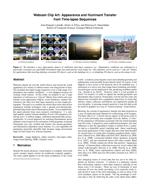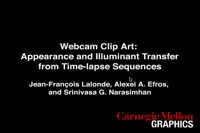Webcam Clip Art:
Appearance and Illuminant Transfer
from Time-lapse Sequences
People
Abstract
Webcams placed all over the world observe and record the visual appearance of a variety of outdoor scenes over long periods of time. The recorded time-lapse image sequences cover a wide range of illumination and weather conditions -- a vast untapped resource for creating visual realism. In this work, we propose to use a large repository of webcams as a "clip art" library from which users may transfer scene appearance (objects, scene backdrops, outdoor illumination) into their own time-lapse sequences or even single photographs. The goal is to combine the recent ideas from data-driven appearance transfer techniques with a general and theoretically-grounded physically-based illumination model. To accomplish this, the paper presents three main research contributions: 1) a new, high-quality outdoor webcam database that has been calibrated radiometrically and geometrically; 2) a novel approach for matching illuminations across different scenes based on the estimation of the properties of natural illuminants (sun, sky, weather and clouds), the camera geometry, and illumination-dependent scene features; 3) a new algorithm for generating physically plausible high dynamic range environment maps for each frame in a webcam sequence.
Citation

|
Jean-François Lalonde, Alexei A. Efros, and Srinivasa G. Narasimhan. Webcam Clip Art: Appearance and Illuminant Transfer from Time-lapse Sequences, ACM Transactions on Graphics (SIGGRAPH Asia 2009), 28(5), 2009. [PDF] [BibTeX] |
Video
 |
[H264, 720x480 NTSC, 63.9MB] |
Talk
Download the slides from the talk given at SIGGRAPH Asia 2009 in the following formats:
- [Apple Keynote, 90.2MB], original version used at SIGGRAPH Asia 2009;
- [MS Powerpoint, 76.2MB], export from Apple Keynote;
- [PDF, 50.8MB], different stages of animations shown.
Dataset
Find the data associated with this paper here.
Code
Download the code for this paper in a ZIP file.
Funding
This research is supported by:
- NSF CCF-0541230
- NSF IIS-0546547
- ONR N00014-08-1-0330
- NSF IIS-0643628
- Microsoft Research Fellowship
- Microsoft Research grant

